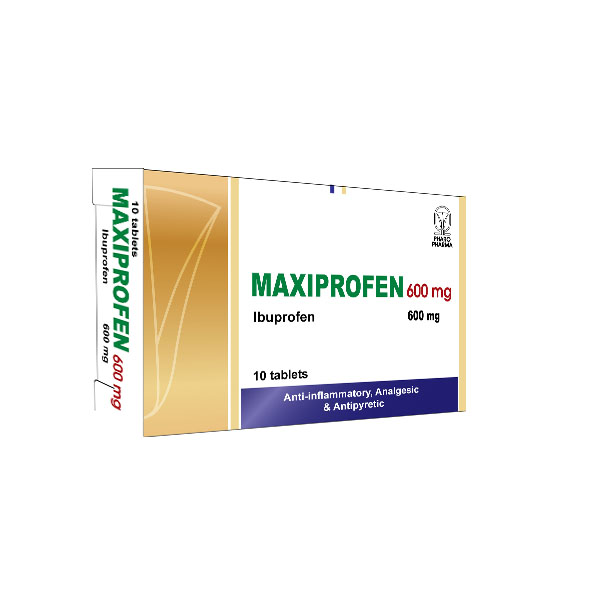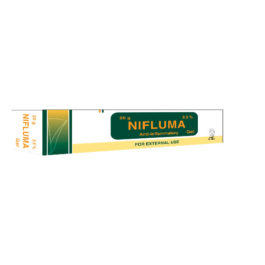Description
Warning
* Cardiovascular Risk
NSAIDs may cause an increased risk of serious cardiovascular thrombotic events, myocardial infarction, and stroke, which can be fatal. This risk may increase with duration of use. Patients with cardiovascular disease of risk factors for cardiovascular disease may be at greater risk. NSAIDs is contraindicated for the treatment of peri-operative pain in the setting of coronary artery bypass graft (CABG) surgery.
*Gastrointestinal Risk
NSAIDs cause an increased risk of serious gastrointestinal adverse events including inflammation, bleeding, ulceration, and perforation of the stomach or intestines, which can be fatal. These events can occur at any time during use and without warning symptoms. Elderly patients are at greater risk for serious gastrointestinal events.
PHARMACEUTICAL FORM
A white, oblong, plain tablet.
CLINICAL PARTICULARS
Therapeutic indications
Maxiprofen 600 tablets is indicated for its analgesic and anti-inflammatory effects in the treatment of rheumatoid arthritis (including juvenile rheumatoid arthritis or Still’s disease), ankylosing spondylitis, osteoarthritis and other non-rheumatoid (seronegative) arthropathies.
In the treatment of non-articular rheumatic conditions, Maxiprofen 600 tablets is indicated in periarticular conditions such as frozen shoulder (capsulitis), bursitis, tendinitis, tenosynovitis and low back pain; Maxiprofen 600 tablets can also be used in soft tissue injuries such as sprains and strains.
Maxiprofen 600 tablets is also indicated for its analgesic effect in the relief of mild to moderate pain such as dysmenorrhoea, dental and post-operative pain and for symptomatic relief of headache, including migraine headache.
Posology and method of administration
Undesirable effects may be minimised by using the lowest effective dose for the shortest duration necessary to control symptoms.
Adults: The recommended dosage of Maxiprofen 600 tablets is 1200-1800 mg daily in divided doses. Some patients can be maintained on 600-1200 mg daily. In severe or acute conditions, it can be advantageous to increase the dosage until the acute phase is brought under control, provided that the total daily dose does not exceed 2400 mg in divided doses. Children: The daily dosage of Maxiprofen 600 tablets is 20 mg/kg of body weight in divided doses.
In Juvenile Rheumatoid Arthritis, up to 40 mg/kg of body weight daily in divided doses may be taken.
Not recommended for children weighing less than 7 kg.
Elderly: The elderly are at increased risk of serious consequences of adverse reactions. If an NSAID is considered necessary, the lowest effective dose should be used and for the shortest possible duration. The patient should be monitored regularly for GI bleeding during NSAID therapy. If renal or hepatic function is impaired, dosage should be assessed individually.
For oral administration. To be taken preferably with or after food.
Contraindications
Maxiprofen 600 tablets is contraindicated in patients with hypersensitivity to the active substance or to any of the excipients. Maxiprofen 600 tablets should not be used in patients who have previously shown hypersensitivity reactions (e.g. asthma, urticaria, angioedema or rhinitis) after taking ibuprofen, aspirin or other NSAIDs. Maxiprofen 600 tablets is also contraindicated in patients with a history of gastrointestinal bleeding or perforation, related to previous NSAID therapy. Maxiprofen 600 tablets should not be used in patients with active, or history of, recurrent peptic ulcer or gastrointestinal haemorrhage (two or more distinct episodes of proven ulceration or bleeding). Maxiprofen 600 tablets should not be given to patients with conditions involving an increased tendency to bleeding. Maxiprofen 600 tablets is contraindicated in patients with severe heart failure, hepatic failure and renal failure.Maxiprofen 600 tablets is contraindicated during the last trimester of pregnancy.
Special warnings and precautions for use
Undesirable effects may be minimised by using the lowest effective dose for the shortest duration necessary to control symptoms. As with other NSAIDs, ibuprofen may mask the signs of infection. The use of Maxiprofen 600 tablets with concomitant NSAIDs, including cyclooxygenase-2 selective inhibitors, should be avoided due to the increased risk of ulceration or bleeding.
Elderly
The elderly have an increased frequency of adverse reactions to NSAIDs, especially gastrointestinal bleeding and perforation, which may be fatal.
Gastrointestinal bleeding, ulceration and perforation
GI bleeding, ulceration or perforation, which can be fatal, has been reported with all NSAIDs at anytime during treatment, with or without warning symptoms or a previous history of serious GI events. The risk of GI bleeding, ulceration or perforation is higher with increasing NSAID doses, in patients with a history of ulcer, particularly if complicated with haemorrhage or perforation, and in the elderly. These patients should commence treatment on the lowest dose available. Combination therapy with protective agents (e.g. misoprostol or proton pump inhibitors) should be considered for these patients, and also for patients requiring concomitant low dose aspirin, or other drugs likely to increase gastrointestinal risk. Patients with a history of gastrointestinal disease, particularly when elderly, should report any unusual abdominal symptoms (especially gastrointestinal bleeding) particularly in the initial stages of treatment.
Caution should be advised in patients receiving concomitant medications which could increase the risk of ulceration or bleeding, such as oral corticosteroids, anticoagulants such as warfarin, selective serotonin-reuptake inhibitors or anti-platelet agents such as aspirin.
When GI bleeding or ulceration occurs in patients receiving Maxiprofen 600 tablets, the treatment should be withdrawn.
NSAIDs should be given with care to patients with a history of ulcerative colitis or Crohn’s disease as these conditions may be exacerbated.
Respiratory disorders
Caution is required if Maxiprofen 600 tablets is administered to patients suffering from, or with a previous history of, bronchial asthma since NSAIDs have been reported to precipitate bronchospasm in such patients.
Cardiovascular, renal and hepatic impairment
The administration of an NSAID may cause a dose dependent reduction in prostaglandin formation and precipitate renal failure. Patients at greatest risk of this reaction are those with impaired renal function, cardiac impairment, liver dysfunction, those taking diuretics and the elderly. Renal function should be monitored in these patients. Maxiprofen 600 tablets should be given with care to patients with a history of heart failure or hypertension since oedema has been reported in association with ibuprofen administration.
Cardiovascular and cerebrovascular effects
Appropriate monitoring and advice are required for patients with a history of hypertension and/or mild to moderate congestive heart failure as fluid retention and oedema have been reported in association with NSAID therapy. Epidemiological data suggest that use of ibuprofen, particularly at a high dose (2400 mg/ daily) and in long term treatment, may be associated with a small increased risk of arterial thrombotic events such as myocardial infarction or stroke. Overall, epidemiological studies do not suggest that low dose ibuprofen (e.g. 1200mg daily) is associated with an increased risk of arterial thrombotic events, particularly myocardial infarction. Patients with uncontrolled hypertension, congestive heart failure, established ischaemic heart disease, peripheral arterial disease, and/or cerebrovascular disease should only be treated with ibuprofen after careful consideration. Similar consideration should be made before initiating longer-term treatment of patients with risk factors for cardiovascular events (e.g. hypertension, hyperlipidaemia, diabetes mellitus, smoking).
Renal effects
Caution should be used when initiating treatment with ibuprofen in patients with considerable dehydration. As with other NSAIDs, long-term administration of ibuprofen has resulted in renal papillary necrosis and other renal pathologic changes. Renal toxicity has also been seen in patients in whom renal prostaglandins have a compensatory role in the maintenance of renal perfusion. In these patients, administration of an NSAID may cause a dose-dependant reduction in prostaglandin formation and, secondarily, in renal blood flow, which may precipitate overt renal decompensation. Patients at greatest risk of this reaction are those with impaired renal function, heart failure, liver dysfunction, those taking diuretics and ACE inhibitors and the elderly. Discontinuation of NSAID therapy is usually followed by recovery to the pre-treatment state.
SLE and mixed connective tissue disease
In patients with systemic lupus erythematosus (SLE) and mixed connective tissue disorders there may be an increased risk of aseptic meningitis .
Dermatological effects
Serious skin reactions, some of them fatal, including exfoliative dermatitis, Stevens-Johnson syndrome, and toxic epidermal necrolysis, have been reported very rarely in association with the use of NSAIDs. Patients appear to be at highest risk of these reactions early in the course of therapy, the onset of the reaction occurring within the first month of treatment in the majority of cases. Maxiprofen 600 tablets should be discontinued at the first appearance of skin rash, mucosal lesions, or any other sign of hypersensitivity.
Haematological effects
Ibuprofen, like other NSAIDs, can interfere with platelet aggregation and has been shown to prolong bleeding time in normal subjects.
Aseptic meningitis
Aseptic meningitis has been observed on rare occasions in patients on ibuprofen therapy. Although it is probably more likely to occur in patients with systemic lupus erythematosus and related connective tissue diseases, it has been reported in patients who do not have an underlying chronic disease.
Impaired female fertility
The use of Maxiprofen 600 tablets may impair female fertility and is not recommended in women attempting to conceive. In women who have difficulties conceiving or who are undergoing investigation of infertility, withdrawal of Maxiprofen 600 tablets should be considered
Interaction with other medicinal products and other forms of interaction
Care should be taken in patients treated with any of the following drugs as interactions have been reported in some patients.
Antihypertensives, beta-blockers and diuretics: NSAIDs may reduce the effect of anti-hypertensives, such as ACE inhibitors, beta-blockers and diuretics. Diuretics can also increase the risk of nephrotoxicity of NSAIDs.
Cardiac glycosides: NSAIDs may exacerbate cardiac failure, reduce GFR and increase plasma cardiac glycoside levels.
Cholestyramine; The concomitant administration of ibuprofen and cholestyramine may reduce the absorption of ibuprofen in the gastrointestinal tract. However, the clinical significance is unknown.
Lithium: Decreased elimination of lithium.
Methotrexate: NSAIDs may inhibit the tubular secretion of methotrexate and reduce clearance of methotrexate.
Ciclosporin: Increased risk of nephrotoxicity.
Mifepristone: A decrease in the efficacy of the medicinal product can theoretically occur due to the antiprostaglandin properties of NSAIDs. Limited evidence suggests that coadministration of NSAIDs on the day of prostaglandin administration does not adversely influence the effects of mifepristone or the prostaglandin on cervical ripening or uterine contractility and does not reduce the clinical efficacy of medicinal termination of pregnancy.
Other analgesics and cyclooxygenase-2 selective inhibitors: Avoid concomitant use of two or more NSAIDs, including Cox-2 inhibitors, as this may increase the risk of adverse effects.
Aspirin: As with other products containing NSAIDs, concomitant administration of ibuprofen and aspirin is not generally recommended because of the potential of increased adverse effects.
Experimental data suggest that ibuprofen may inhibit the effect of low dose aspirin on platelet aggregation when they are dosed concomitantly. However, the limitations of these data and the uncertainties regarding extrapolation of ex vivo data to the clinical situation imply that no firm conclusions can be made for regular ibuprofen use, and no clinically relevant effect is considered to be likely for occasional use.
Corticosteroids: Increased risk of gastrointestinal ulceration or bleeding with NSAIDs.
Anticoagulants: NSAIDs may enhance the effects of anticoagulants, such as warfarin.
Quinolone antibiotics: Animal data indicate that NSAIDs can increase the risk of convulsions associated with quinolone antibiotics. Patients taking NSAIDs and quinolones may have an increased risk of developing convulsions.
Sulfonylureas: NSAIDs may potentiate the effects of sulfonylurea medications. There have been rare reports of hypoglycaemia in patients on sulfonylurea medications receiving ibuprofen.
Anti-platelet agents and selective serotonin reuptake inhibitors (SSRIs): Increased risk of gastrointestinal bleeding with NSAIDs.
Tacrolimus: Possible increased risk of nephrotoxicity when NSAIDs are given with tacrolimus.
Zidovudine: Increased risk of haematological toxicity when NSAIDs are given with zidovudine. There is evidence of an increased risk of haemarthroses and haematoma in HIV(+) haemophiliacs receiving concurrent treatment with zidovudine and ibuprofen.
Aminoglycosides: NSAIDs may decrease the excretion of aminoglycosides.
Herbal extracts: Ginkgo biloba may potentiate the risk of bleeding with NSAIDs.
CYP2C9 Inhibitors: Concomitant administration of ibuprofen with CYP2C9 inhibitors may increase the exposure to ibuprofen (CYP2C9 substrate). In a study with voriconazole and fluconazole (CYP2C9 inhibitors), an increased S(+)-ibuprofen exposure by approximately 80 to 100% has been shown. Reduction of the ibuprofen dose should be considered when potent CYP2C9 inhibitors are administered concomitantly, particularly when high-dose ibuprofen is administered with either voriconazole or fluconazole.
Pregnancy and lactation
Pregnancy
Inhibition of prostaglandin synthesis may adversely affect the pregnancy and/or embryo/foetal development. Data from epidemiological studies suggest an increased risk of miscarrage and of cardiac malformation and gastroschisis after the use of a prostaglandin synthesis inhibitor in early pregnancy. In animals, the administration of a prostaglandin synthesis inhibitor has been shown to result in increased pre- and post-implantation losses and embryo/foetal lethality. In addition, increased incidences of various malformations, including cardiovascular, have been reported in animals given a prostaglandin synthesis inhibitor during the organogenetic period. During the first and second trimester of pregnancy, Maxiprofen 600 should not be given unless clearly necessary. If Maxiprofen 600 is used by a woman attempting to conceive, or during the first or second trimester of pregnancy, the dose should be kept as low and duration of treatment as short as possible. During the third trimester of pregnancy, all prostaglandin synthesis inhibitors may expose the foetus to the following:
• Cardiopulmonary toxicity (with premature closure of the ductus arteriosus and pulmonary hypertension)
• Renal dysfunction, which may progress to renal failure with oligohydramnios.
At the end of pregnancy, prostaglandin synthesis inhibitors may expose the mother and the neonate to the following:
• Possible prolongation of bleeding time
• Inhibition of uterine contractions, which may result in delayed or prolonged labour. Consequently, Maxiprofen 600 is contraindicated during the third trimester of pregnancy.
Lactation
In the limited studies so far available, NSAIDs can appear in the breast milk in very low concentrations. NSAIDs should, if possible, be avoided when breastfeeding.
Effects on ability to drive and use machines
Undesirable effects such as dizziness, drowsiness, fatigue and visual disturbances are possible after taking NSAIDs. If affected, patients should not drive or operate machinery.
Undesirable effects
Gastrointestinal disorders: The most commonly observed adverse events are gastrointestinal in nature. Peptic ulcers, perforation or GI bleeding, sometimes fatal, particularly in the elderly, may occur. Nausea, vomiting, diarrhoea, flatulence, constipation, dyspepsia, abdominal pain, melaena, haematemesis, ulcerative stomatitis, exacerbation of colitis and Crohn’s disease have been reported following ibuprofen administration. Less frequently, gastritis has been observed. Gastrointestinal perforation has been rarely reported with ibuprofen use. Pancreatitis has also been reported very rarely.
Immune system disorders: Hypersensitivity reactions have been reported following treatment with NSAIDs. These may consist of (a) non-specific allergic reaction and anaphylaxis, (b) respiratory tract reactivity comprising asthma, aggravated asthma, bronchospasm or dyspnoea, or (c) assorted skin disorders, including rashes of various types, pruritus, urticaria, purpura, angioedema and, more rarely, exfoliative and bullous dermatoses (including Stevens-Johnson syndrome, toxic epidermal necrolysis and erythema multiforme).
Cardiac disorders and vascular disorders: Oedema, hypertension and cardiac failure have been reported in association with NSAID treatment. Epidemiological data suggest that use of ibuprofen, particularly at high dose (2400 mg/ daily), and in long term treatment, may be associated with a small increased risk of arterial thrombotic events such as myocardial infarction or stroke.
Other adverse events reported less commonly and for which causality has not necessarily been established includes:
Blood and lymphatic system disorders: Leukopenia, thrombocytopenia, neutropenia, agranulocytosis, aplastic anaemia and haemolytic anaemia
Psychiatric disorders: Insomnia, anxiety, depression, confusional state, hallucination
Nervous system disorders: Optic neuritis, headache, paraesthesia, dizziness, somnolence
Infections and infestations: Rhinitis and aseptic meningitis (especially in patients with existing autoimmune disorders, such as systemic lupus erythematosus and mixed connective tissue disease) with symptoms of stiff neck, headache, nausea, vomiting, fever or disorientation.
Eye disorders: Visual impairment and toxic optic neuropathy
Ear and labyrinth disorders: Hearing impaired, tinnitus and vertigo
Hepatobiliary disorders: Abnormal liver function, hepatic failure, hepatitis and jaundice
Skin and subcutaneous tissue disorders: Bullous reactions, including Stevens-Johnson syndrome and toxic epidermal necrolysis (very rare), and photosensitivity reaction
Renal and urinary disorders: Impaired renal function and toxic nephropathy in various forms, including interstitial nephritis, nephrotic syndrome and renal failure
General disorders and administration site conditions: Malaise, fatigue.
Overdose
Toxicity
Signs and symptoms of toxicity have generally not been observed at doses below 100 mg/kg in children or adults. However, supportive care may be needed in some cases. Children have been observed to manifest signs and symptoms of toxicity after ingestion of 400 mg/kg or greater.
Symptoms
Most patients who have ingested significant amounts of ibuprofen will manifest symptoms within 4 to 6 hours.
The most frequently reported symptoms of overdose include nausea, vomiting, abdominal pain, lethargy and drowsiness. Central nervous system (CNS) effects include headache, tinnitus, dizziness, convulsion, and loss of consciousness. Nystagmus, metabolic acidosis, hypothermia, renal effects, gastrointestinal bleeding, coma, apnoea, diarrhoea and depression of the CNS and respiratory system have also been rarely reported. Disorientation, excitation, fainting and cardiovascular toxicity, including hypotension, bradycardia and tachycardia have been reported. In cases of significant overdose, renal failure and liver damage are possible. Large overdoses are generally well tolerated when no other drugs are being taken.
Therapeutic measures
Patients should be treated symptomatically as required. Within one hour of ingestion of a potentially toxic amount, activated charcoal should be considered. Alternatively, in adults, gastric lavage should be considered within one hour of ingestion of a potentially life-threatening overdose. Good urine output should be ensured. Renal and liver function should be closely monitored. Patients should be observed for at least four hours after ingestion of potentially toxic amounts. Frequent or prolonged convulsions should be treated with intravenous diazepam. Other measures may be indicated by the patient’s clinical condition.
PHARMACOLOGICAL PROPERTIES
Pharmacodynamic properties
Ibuprofen is a propionic acid derivative with analgesic, anti-inflammatory and anti-pyretic activity. The drug’s therapeutic effects as an NSAID is thought to result from its inhibitory effect on the enzyme cyclo-oxygenase, which results in a marked reduction in prostaglandin synthesis.
Experimental data suggest that ibuprofen may inhibit the effect of low dose aspirin on platelet aggregation when they are dosed concomitantly. In one study, when a single dose of ibuprofen 400mg was taken within 8 hours before or within 30 minutes after immediate release aspirin dosing (81mg), a decreased effect of aspirin on the formation of thromboxane or platelet aggregation occurred. However, the limitations of these data and the uncertainties regarding extrapolation of ex vivo data to the clinical situation imply that no firm conclusions can be made for regular ibuprofen use, and no clinically relevant effect is considered to be likely for occasional ibuprofen use.
Pharmacokinetic properties
Ibuprofen is rapidly absorbed from the gastrointestinal tract, peak serum concentrations occurring 1-2 hours after administration. The elimination half-life is approximately 2 hours. Ibuprofen is metabolized in the liver to two inactive metabolites and these, together with unchanged ibuprofen, are excreted by the kidney either as such or as conjugates. Excretion by the kidney is both rapid and complete. Ibuprofen is extensively bound to plasma proteins.
PHARMACEUTICAL PARTICULARS
List of excipients
Lactose monohydrate, tribasic calcium phosphate, pregelatinized starch, croscarmellose sodium, magnesium stearate, titanium dioxide, talc powder.
Special precautions for storage
– Store at a temperature not exceeding 30˚C, in dry place.
– Store all medicine out of reach of children .
Nature and contents of container
Carton box containing 10 tablets in AL/PVC strip and a pamphlet.








Reviews
There are no reviews yet.